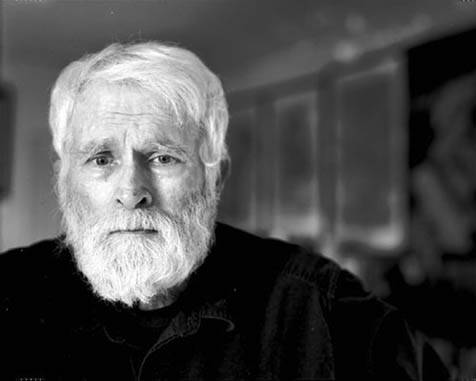R. B. Kitaj 1932-2007

Ronald Brooks “R. B.” Kitaj died in Los Angeles on October 21. An American artist who spent most of his adult life in London, Kitaj was among the most ambitious figurative painters of the late 20th century. Associated for a short time with the emergence of pop art in Britain, Kitaj had the distinction of naming his own movement, the “School of London,” which included such illustrious neighbors as Francis Bacon, Frank Auerbach, Leon Kossoff, David Hockney, Michael Andrews, and Lucian Freud.
Kitaj’s best-known work, an allegorical painting called “If Not, Not” (1975-1976), is based on “The Tempest” by Giorgione but also takes as its subjects T. S. Eliot’s “The Wasteland” and the Holocaust. Both Eliot and the gate of Auschwitz appear in the picture. A tapestry based on “If Not, Not” hangs in the main entrance hall of the British Library, a fitting memorial to the book-mad Kitaj, who in 1991 became the first American to be included as a full member of the Royal Academy since John Singer Sargent in 1897. Kitaj was particularly renowned as a draftsman and was considered by many of his contemporaries-including his close friend David Hockney and art critic Robert Hughes-to have had the greatest natural skill in drawing of his generation.
Kitaj was born in Cleveland and traveled the world in his early twenties as a merchant seaman. He trained in art at the Ruskin School, Oxford, as a beneficiary of the GI Bill after serving in occupied Germany during the Korean War. The Los Angeles County Coroner’s Office deferred labeling Kitaj’s death a suicide pending the results of an autopsy. There were signs, particularly in Kitaj’s recently published writing, that he had been considering taking his own life.
Kitaj moved to Los Angeles in the mid 1990s in the wake of a series of tragic events that began with what should have been one of his greatest triumphs-a career retrospective at the Tate Museum in 1994. Critics in the British press attacked Kitaj’s Tate exhibit savagely, maligning Kitaj as a pretentious poseur who did more name dropping than painting. Kitaj took their criticism very personally, lashing back at his foes by claiming that “anti-intellectualism, anti-Americanism, and anti-Semitism” had animated their abuse.
At the height of what came to be known among Kitaj and his followers as “the Tate Wars,” Kitaj was called home to attend his mother’s deathbed in Cleveland, and, while he was away, his second wife, Sandra Fisher, died of a brain aneurysm. Kitaj-already incensed at what he believed to be an attempt on the part of the British press to destroy his career-immediately termed Fisher’s death a murder, saying that, “they were aiming for me, but they got her instead.” Despite the apparent outlandishness of Kitaj’s claim for the impact of art criticism, several of his friends, including David Hockney, concurred, stating that they too believed the London reviewers had killed Sandra Fisher.
Not since 1821-when Percy Shelley wrote in the preface to “Adonais,” an elegy for fellow poet John Keats, that the “savage criticism on his Endymion, which appeared in the Quarterly Review, produced the most violent effect on his susceptible mind; the agitation thus originated ended in the rupture of a blood vessel in the lungs; a rapid consumption ensued, and the succeeding acknowledgements from more candid critics of the true greatness of his powers were ineffectual to heal the wounds thus wantonly afflicted”-has such a direct claim been made by a major public figure for the fatal impact of negative reviews. Like Keats, Sandra Fisher was an inspired artist in her own right, and many students of Kitaj consider her responsible for both his productivity in the 1980s and 1990s and for the other great obsession of Kitaj’s later years, his identity as a member of the Jewish diaspora.
Beginning with the publication of his First Diasporist Manifesto in 1989, Kitaj became one of the most outspoken proponents of identity politics in the art of the period. Coming at the height of the so-called “culture wars”-during which many artists and intellectuals were profoundly influenced by the concept of the “burden of representation,” which holds that those who have experienced a particular form of oppression as a result of their racial, gender, or ethnic identity are uniquely qualified to represent their experience to others-Kitaj’s at-times grandiose claims for his own status as a cultural (rather than practicing religious) Jew nevertheless provoked widespread dismay. Whether this lack of acceptance for Kitaj’s grand project was due to its timing, Kitaj’s manner of proposing it, or simply fashions in academic intellectual sympathy, the result was a disconnection between Kitaj and a significant portion of his existing critical audience, which had until then supported his bookishness and perennial interest in the figure. The culmination of critical suspicion about Kitaj’s seemingly obsessive interest in the Jewish diaspora coincided with the negative reviews of his 1994 exhibition at the Tate, resulting in a fusion in Kitaj’s mind of his wife’s death and the more generalized fate of Jews in the twentieth century.
At the core of Kitaj’s intellectual universe stands the ultimate icon of so-called secular Judaism, Franz Kafka. From Kafka, Kitaj took a love of paradox that defined for him what counts as hope after the Holocaust. In the Second Diasporist Manifesto (2007), Kitaj refers to a statement of Kafka’s that, “if it had been possible to build [the tower of Babel] without ascending it, it would have been permitted.” Kitaj follows this paraphrase with an idea for a painting, and perhaps also an intimation of his own end. Kitaj writes, “CLIMB THE TOWER AND TALK WITH GOD FACE-TO-FACE. Idea for a painting! The Tower should be quite endless, sort of, which is one swell pictorial problem. Check out Breughel of course. The Tower of Babel (in Genesis) is unfinished, so maybe I should finish it and die.”



